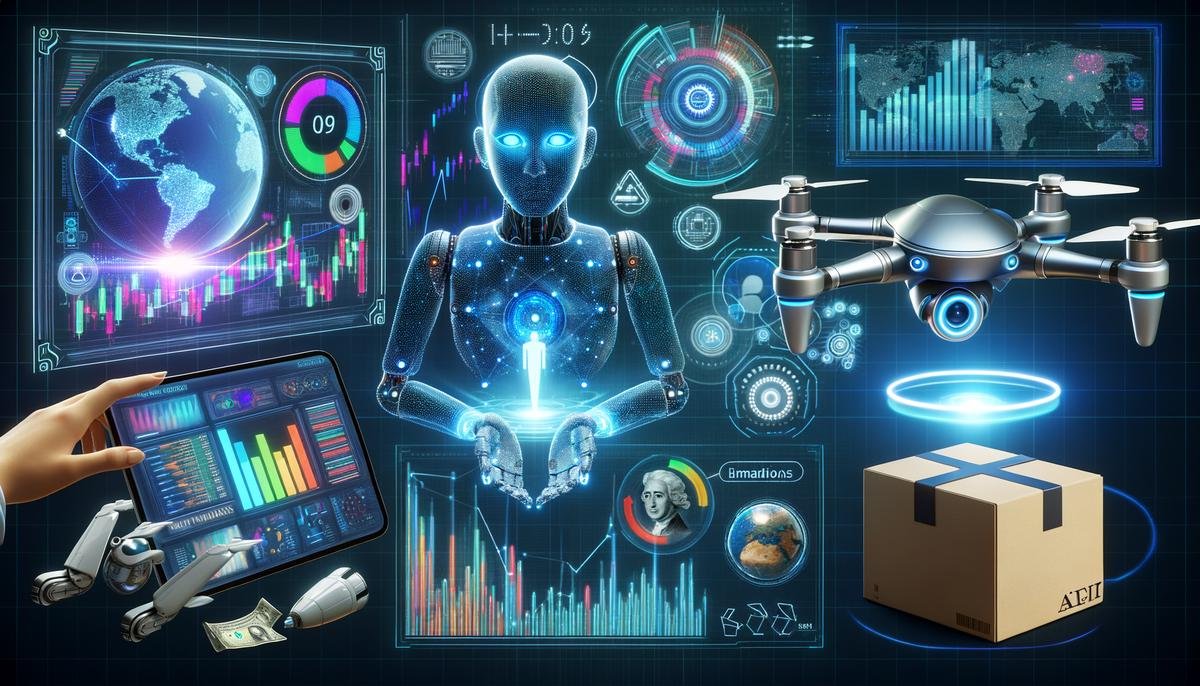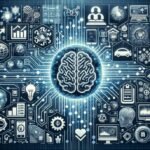The Role of AI in Streamlining Supply Chains
How AI is Revolutionizing Supply Chain Management
In today’s fast-paced world, businesses are always on the lookout for ways to stay ahead of the curve, and one game-changer has been AI – yes, artificial intelligence! It’s not just sci-fi material anymore; AI is revolutionizing how supply chains operate, making them smarter, faster, and frankly, more awesome. Let’s dive into how this tech is giving the supply chain world a massive makeover.
Predicting the Future Like a Fortune Teller
First off, AI’s predictive powers are like having a crystal ball for your supply chain. Imagine being able to predict demand spikes before they happen. With AI, you’re not just guessing; you’re using hardcore data. This means you can adjust your inventory in real-time, avoiding overstock situations or, worse, running out of hot-ticket items. It’s like being psychic, but cooler because, well, technology!
Playing Matchmaker with Supply and Demand
AI also plays cupid by matching supply with demand perfectly. It analyzes patterns and trends to ensure that production levels are always in harmony with what customers want. This love story results in happier customers and a smoother operation, cutting down waste and boosting efficiency. Who knew AI could be such a good matchmaker?
A Logistics Whiz Kid
Then there’s the logistics side of things, where AI is nothing short of a whiz kid. Routing and delivery optimization are game-changers. AI algorithms can determine the most efficient delivery routes in real-time, considering factors like traffic, weather, and delivery windows. This means quicker deliveries, lower costs, and a greener planet since we’re cutting down on fuel consumption. Talk about a triple win!
The Quality Control Cop
Quality control is another area where AI shines bright. Imagine having an eagle-eyed cop monitoring your products, ensuring everything meets the gold standard. AI-powered visual inspection systems can spot defects faster and more accurately than human eyes, leading to higher quality products hitting the shelves. It’s like having a superhero on your quality control team.
The Ultimate Problem Solver
Lastly, AI is the ultimate problem solver. Supply chain hiccups? AI’s on it. It can analyze heaps of data to pinpoint issues and suggest solutions before they turn into headaches. Plus, with machine learning, AI gets smarter over time, learning from past snafus to avoid future ones. It’s like having a wise mentor guiding your supply chain to Zen levels of smoothness.
So, there you have it. AI in supply chain management isn’t just about fancy robots doing backflips (though that’d be cool). It’s about making smarter decisions, avoiding pitfalls, and keeping customers smiling from ear to ear. With AI, the future of supply chains looks brighter than ever, proving that technology indeed has the power to transform the way we do business. Here’s to a future where supply chains are not just efficient but downright intelligent, all thanks to AI.

AI-driven Innovations in Product Development
Exploring the Creative Genius of AI in Product Development
Diving into the world of product development, artificial intelligence (AI) is not just about crunching numbers or predicting the next big trend. It’s revolutionizing the way we create, test, and improve products, making the process more efficient and insightful. Let’s unpack some of the game-changing innovations AI has introduced to product design and development.
1. Supercharging Product Design with AIStarting with the drawing board, AI is bringing a whole new level of innovation to product design. Imagine design software that not only helps you sketch but also suggests optimizations, anticipates potential manufacturing issues, and even predicts how users will interact with your product. This isn’t a scene from a sci-fi movie; it’s what AI is doing right now in the product development arena. Designers and engineers can iterate rapidly, test out wild ideas, and refine their creations in ways that were previously unthinkable.
2. Revolutionizing Prototyping with Rapid SimulationsRemember when creating a prototype was a time-consuming and costly affair? AI is changing that story. Now, with AI-powered simulation tools, product developers can test hundreds of variations of a product in the virtual world before even creating a single physical prototype. These simulations can forecast how a product will perform under various conditions, identify weak points, and suggest improvements—all at a fraction of the time and cost.
3. Personalizing Products at ScaleEver dreamt of offering bespoke products to every customer without breaking the bank? AI is making personalized product development feasible and affordable. By analyzing vast amounts of customer data, AI algorithms can pinpoint specific preferences and needs. This insight allows companies to design products or adapt features to match individual consumer profiles, creating a personalized experience at scale.
4. Boosting Sustainability Through Smart Material SelectionSustainability is a huge focus in product development, and AI is stepping up to the challenge. AI can analyze the environmental impact of different materials, production methods, and product life cycles, guiding developers toward greener choices. It’s like having an eco-conscious advisor in your design team, constantly nudging you towards decisions that are better for the planet.
5. Enhancing User Experience with Predictive AnalysisWhat if you could predict how customers will use and interact with your product before it even hits the market? AI’s predictive analytics capabilities are making this possible. By sifting through data on consumer behavior, market trends, and product performance, AI can forecast how a new product will fare in the real world. This allows teams to make informed adjustments to the user experience, creating products that truly resonate with their target audience.
6. Streamlining Feedback Loops with Sentiment AnalysisLast but definitely not least, AI is transforming how companies gather and act on customer feedback. Through sentiment analysis, AI tools can sift through social media posts, reviews, and customer interactions to gauge public sentiment towards a product. This real-time feedback loop helps product developers quickly identify issues, make adjustments, and continuously improve their offerings.
To wrap it up, AI is not just a tool but a creative partner in the product development process. It’s opening doors to innovations that were once deemed impossible, facilitating a new era of creativity, efficiency, and personalization. From the initial sketch to the final product launch, AI is there, making sure we’re not just building faster and cheaper, but smarter. So, the next time you marvel at a groundbreaking product, there’s a good chance AI had a hand in shaping it. Welcome to the future of product development, where artificial intelligence and human ingenuity are crafting the world of tomorrow, today.
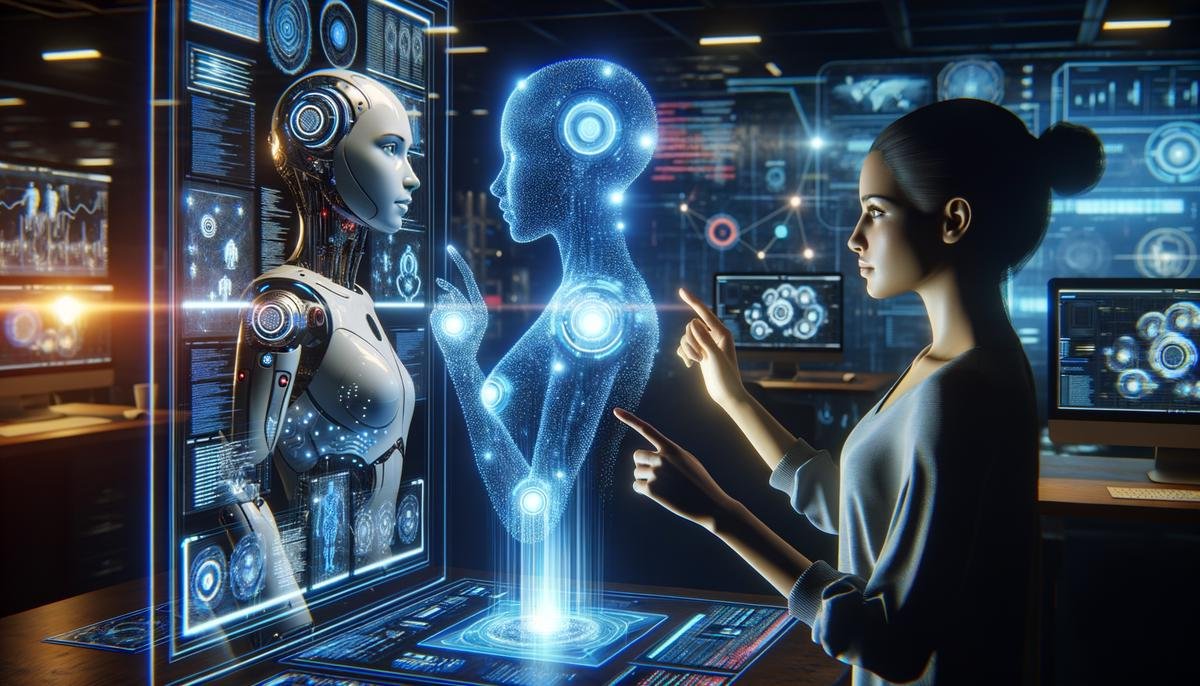
The Impact of AI on Global Trade Policies
**Navigating New Frontiers: How AI is Shaping Global Trade Policies**
In the rapidly evolving landscape of global commerce, Artificial Intelligence (AI) emerges as a pioneering force, not only transforming supply chains and product design but also significantly influencing global trade policies. As nations grapple with the pace of AI advancements, the conversation around crafting effective, fair trade policies is more crucial than ever.
**AI’s Role in Customs and Trade Regulations**
Picture this: a world where customs processes are smooth, fast, and fraud-free. AI makes this possible by enhancing risk management and compliance checks in customs operations. By analyzing patterns and data, AI can predict potential issues, reduce human errors, and speed up the movement of goods. This capability isn’t just a convenience; it’s a game changer for global trade, prompting policymakers to reconsider their regulatory frameworks to accommodate and leverage these AI-driven efficiencies.
**Intellectual Property Concerns in the AI Era**
The explosion of AI-driven innovation brings into sharp relief the challenges of protecting intellectual property (IP). AI can design, “invent,” or improve products autonomously, raising questions like: Who owns an AI-created design? Current IP laws weren’t built with AI in mind, pushing policymakers to explore new legal territories. This exploration isn’t merely academic; it shapes international agreements and trade policies, ensuring creators – human or AI – are fairly rewarded, fostering a healthy environment for continued innovation.
**Trade Strategies and AI’s Predictive Analytics**
Beyond borders, AI’s predictive analytics are reshaping how countries approach their trade strategies. With AI’s ability to forecast market trends and economic shifts, nations are better equipped to navigate the complexities of international trade. This foresight allows for more strategic resource allocation, investment decisions, and policy planning, encouraging a proactive rather than reactive stance on the global stage. As a result, bilateral and multilateral trade agreements are increasingly considering AI’s role in economic predictions, adapting policies to safeguard and promote economic interests in an AI-dominated future.
**AI’s Impact on Workforce and Skill Requirements**
AI’s influence extends to the workforce, necessitating a revamp of labor policies and trade agreements to address the shift in skill requirements. As AI automates routine tasks, the demand for advanced technical skills skyrockets, urging countries to invest in education and training programs. Similarly, trade policies are evolving to include provisions for labor mobility and skill development, recognizing that the workforce’s ability to adapt to AI-driven changes is crucial for sustaining economic growth and competitiveness.
**Ethical and Security Considerations in AI Trade Policies**
Finally, the global race to harness AI’s power brings ethical and security concerns to the forefront of trade policy discussions. The potential misuse of AI in surveillance, cybersecurity risks, and the propagation of biases necessitates a careful balancing act. Policymakers are tasked with drafting policies that encourage AI’s positive growth while implementing safeguards against its risks. International collaborations and agreements focusing on AI ethics and security standards are becoming a staple in trade discussions, aiming to build a framework for responsible AI development and use across borders.
**Zooming In on the Future**
As AI continues to redefine the possibilities in global trade, policymakers are at a crossroads. The journey ahead involves navigating the challenges of integrating AI into trade policies while capitalizing on its benefits. By fostering international cooperation, prioritizing ethics and workforce development, and adapting regulatory frameworks, the potential of AI to drive equitable, sustainable growth in global trade can be fully realized. The conversation around AI and trade policies is vibrant, ever-evolving, and pivotal to shaping a future where technology and commerce harmoniously intersect, promising a new dawn in global economic relations.
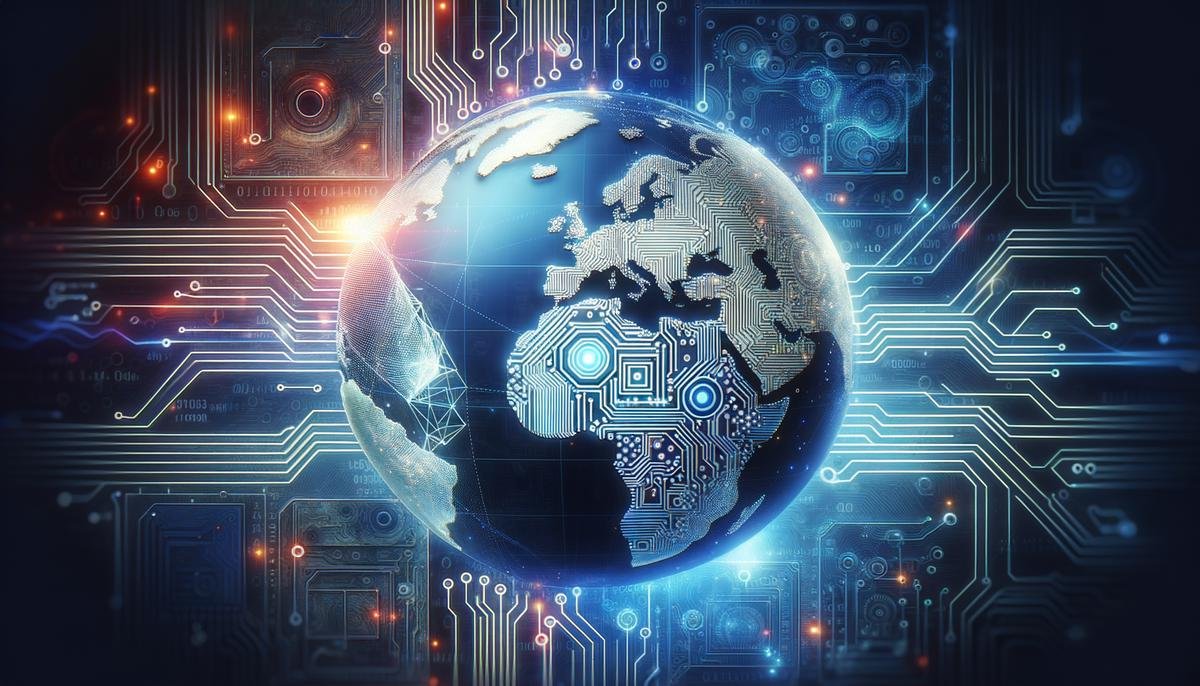
Ethical Considerations and AI in Global Trade
In the dazzling arena of global trade, the role of Artificial Intelligence (AI) can’t be overstated – it’s like the superhero we never knew we needed. But, with great power comes great responsibility, and the ethical considerations of using AI in international trade are like navigating a minefield in a snowstorm. Let’s dive deep without making our heads spin, shall we?
First off, the charm of AI in leveling the playing field is akin to giving small businesses a jetpack. Suddenly, David can not only stand up to Goliath but also outmaneuver him with data-driven strategies. However, this raises the question: What about data privacy? Imagine personal and business data zooming around like gossip in a small town. It’s crucial to ensure this information is as secure as Fort Knox, avoiding the sinister clutches of data breaches that could turn our digital utopia into a dystopian nightmare.
Then, there’s the conundrum of job displacement. It’s no secret that AI can work like a tireless, hyper-efficient employee. But, what happens to the human employees? Here’s where ethics waltz in. The global trade scene must not become a cold place where machines replace humans willy-nilly. Rather, it’s about choreographing a harmonious dance where AI enhances human skills, not replaces them. Re-skilling and up-skilling become the buzzwords, creating a future where human ingenuity and AI’s capabilities tango in perfect sync.
Diving deeper, we encounter the specter of inequality. The AI revolution in trade could inadvertently become an exclusive party, where only the countries with the shiniest toys (read: most advanced AI) get to lead the conga line. This digital divide could yawn wider, leaving developing nations in the dust. The ethical path forward involves crafting international AI policies that sprinkle a little fairy dust on all, ensuring technology transfer and support mechanisms that allow every nation to ride the AI wave.
Lastly, let’s talk about the global marketplace itself – a vast ocean where AI ships navigate. The ethical use of AI demands transparency and fairness in algorithms that dictate trade flows. No secret, biased codes skewing the market, please! An ethical AI in trade is like a fair referee in a football match, ensuring no team has an unfair advantage because of some sneaky, behind-the-scenes shenanigans.
As we zoom out, it’s evident that wielding the power of AI in global trade is as much about nurturing a soul for technology as it is about crunching numbers. From safeguarding data privacy and securing jobs to bridging the digital divide and ensuring algorithmic fairness, the aim is to foster a trade landscape where AI is not just a tool but a trusted ally in building a more equitable world.
So, there you have it – a whirlwind tour through the ethical maze of AI in global trade. It’s a brave new world out there, and navigating it wisely demands a compass that points towards not just innovation, but integrity as well. Here’s to the journey ahead, where ethics and AI join hands to chart a course towards a future that’s bright for all, not just a select few. And remember, in the grand tapestry of global trade, every thread matters, painting a picture that’s as ethical as it is entrepreneurial.
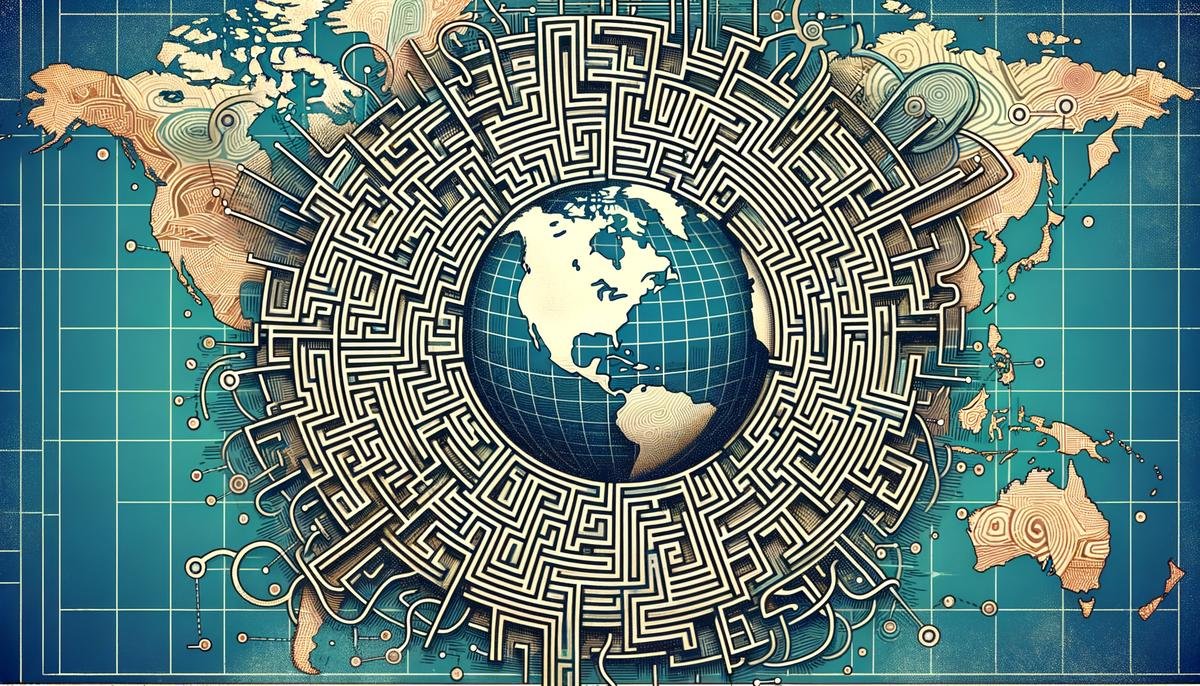
Future Trends: AI and the Evolution of Global Trade
Peeking into the Crystal Ball: The Next Wave of AI-Driven Trade Innovations
As we sail through the 21st century, the fusion of artificial intelligence (AI) and global trade is not just inevitable; it’s already happening. You’ve seen how AI has started to reshape supply chain management, personalize products, and even juggle complex customs regulations. But hold onto your hats, because what’s coming next is going to blow your mind!
Smart Contracts and Blockchain: A Match Made in Digital Heaven
Think of smart contracts as your super trustworthy digital pals, ensuring every trade agreement is adhered to, down to the last letter. Combined with blockchain, they’re about to revolutionize how we handle transactions, providing a level of transparency and security we’ve only dreamed of. Imagine international deals being executed flawlessly, without the need for intermediaries. This is not just efficiency on steroids; it’s a trust revolution.
Digital Twins: Creating Virtual Mirrors of the Physical World
Digital twins are about to take product development and supply chain management by storm. Imagine having a digital clone of your entire supply chain, replicating every detail, from manufacturing to delivery. These virtual models allow companies to predict complications, streamline operations, and optimize performance without risking real-world chaos. The potential for cost savings and efficiency boosts is enormous, making the future of trade operations look like something out of a sci-fi novel.
AI-Driven Trade Financing: Smoothing Out the Financial WrinklesAccess to financing can be a thorn in the side of global trade, but AI is about to change all that. With algorithms that can evaluate risks and opportunities in the blink of an eye, getting trade financing could become as easy as ordering a coffee. Smaller companies, often left out in the cold, will now have a fighting chance to participate on the global stage. It’s not just about leveling the playing field; it’s about expanding the game.
Hyper-Personalization: The Customer is Really KingGone are the days of one-size-fits-all. AI is pushing hyper-personalization to dizzying heights, creating products and services tailored to each individual’s preferences and needs. From fashion to tech gadgets, expect offerings so aligned with your desires, it’ll feel like they were designed just for you. And it’s not just about making consumers happy; it’s about redefining consumer expectations entirely.
Language and Cultural Barriers: Tearing Down the Walls
Language and culture have long been barriers in global trade, but AI’s advanced natural language processing capabilities are about to make these obstacles a thing of the past. Real-time translation and cultural adaptation services will allow businesses to communicate and operate in any market as if they were locals. This isn’t just good news for business expansion; it’s a giant leap towards a more interconnected world economy.
Navigating the Regulatory Maze with AI Guides
Regulations can be a complex beast, particularly when you’re dealing with multiple countries. AI-driven tools are set to simplify this maze, offering real-time guidance and compliance solutions. This means businesses can stay ahead of the curve, avoiding penalties and delays that can cost dearly. It’s like having a regulatory GPS at your fingertips, guiding you through the trickiest of terrains.
Towards a Greener Trade HorizonSustainability is no longer a buzzword; it’s a business imperative. AI is gearing up to lead the charge towards greener trade practices, optimizing routes, reducing waste, and enhancing energy efficiency across the board. This is not just about saving the planet; it’s about future-proofing businesses in a world where green credentials will be as critical as profitability.
The journey into the future of AI-driven global trade is poised to be one of the most thrilling adventures of our time. With every stride, we’re not just reshaping how business is done; we’re reimagining what’s possible. Strap in, because the trade landscape of tomorrow looks nothing like today. And that, dear reader, is an exciting prospect indeed.
